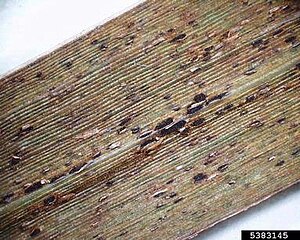Puccinia emaculata
| Puccinia emaculata | ||||||||||||
|---|---|---|---|---|---|---|---|---|---|---|---|---|

Puccinia emaculata on switchgrass |
||||||||||||
| Systematics | ||||||||||||
|
||||||||||||
| Scientific name | ||||||||||||
| Puccinia emaculata | ||||||||||||
| Schweinitz |
Puccinia emaculata is a stand fungal art from the order of the rust fungi (Pucciniales). The fungus is an endoparasite of milkweed and various millets . Symptoms of the infestation by the species are rust spots and pustules on the leaf surfaces of the host plants. It occurs in eastern North America and Chile .
features
Macroscopic features
Puccinia emaculata can only be recognized with the naked eye by the spore beds protruding on the surface of the host. They grow in nests that appear as yellowish to brown spots and pustules on the leaf surfaces.
Microscopic features
The mycelium of Puccinia emaculata grows as with all Puccinia TYPES intercellular and forms Saugfäden that grow into the storage tissue of the host. The aecia of the species have 20–32 × 16–23 µm large, spherical or ellipsoidal, hyaline aeciospores with a wrinkled surface. The cinnamon-brown uredia of the species mostly grow on the top of the leaves of the host plants. Their uredospores, which are also cinnamon brown, are broadly ellipsoidal to spherical, 21–27 × 20–24 µm in size and finely spiky. The upper-side growing parts of the species are black-brown and uncovered early. The hazel-brown teliospores of the fungus are two-celled, usually ellipsoidal to narrowly ovate and 33–44 × 17–21 µm in size. Their stem is colorless and up to 80 µm long.
distribution
The known distribution area of Puccinia emaculata includes North America east of the Rocky Mountains and Chile .
ecology
The host plants of Puccinia emaculata are for the Haplonts milkweed ( Euphorbia spp.) As well as Paspalum stramineum , Sacciolepsis striatus and various Panicum species for the dikaryote . The fungus feeds on the nutrients present in the storage tissue of the plants, its spore beds later break through the leaf surface and release spores. The species has a development cycle with Telien, Uredien, Spermogonia and Aecien and changes host.
literature
- George B. Cummins: The Rust Fungi of Cereals, Grasses and Bamboos . Springer, Berlin 1971, ISBN 3-540-05336-0 .
